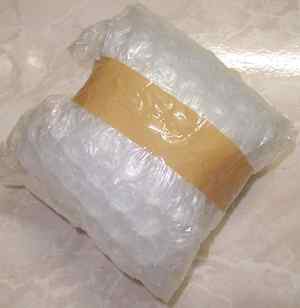|
Shipping Porcelain
(Packaging)
How to securely pack when shipping porcelain...
Only two or three methods are suitable for shipping ceramics
internationally. These are proven to be less prone to
breakage when shipping very long distances. They all involve
artificial packing materials which are flexible.
Other methods may be feasible, but those involving newspaper
are definitely NOT suitable for shipping porcelain! If you
are the buyer and buy porcelain from a seller packing with
newspaper – RUN!
Bad example -- the
packaging material shown below was actually used, resulting
in two broken porcelain plates:

There is a very high risk that a porcelain item packed with
newspaper does not arrive intact if sent to the other side
of the globe. The longer the journey until arrival the
higher is the risk that it breaks.
Newspaper and other "natural" materials are NOT proper
packaging material for shipping porcelain! Newspaper doesn't
really have any elasticity. The crumpled paper only appears
flexible because of the air in between, when the crumpled
paper is pressed on. With continued pressure from the packed
item's weight, and the vibrations or shaking during
transport, etc. filling materials like newspaper easily get
compressed.
The items surrounded by crumpled paper tend to move sideways
or downwards with the continuous vibrations of vehicles,
airplanes and the inevitable conveying systems used by large
handling centers of the post, and on airports.
The initial, apparent flexibility is lost and the paper
settles or moves inside the box. Once it settles (is
compressed) its flexibility is greatly reduced and at the
same time the volume of the package content decreases also.
This again leaves less voluminous loose filler material and
more empty spaces. The problem is - the filler material
should be tightly holding the porcelain in place!
Continuously exposed to vibrations and shaking during a long
journey all flexibility is lost. The content inevitably
changes location within the box and often moves dangerously
close to the bottom or side walls of the box. Always be
aware that while items packed that way may be fine during
short-distance shipping, domestically, within Europe, etc.,
the long journey to other continents will often break them
if packed that way.
Is it a wonder? Todays
parcels are exposed to vibrations all the time when they are
in transit. First on the different transport vehicles when
they are moved from a post office to an airport handling
center, then they may be exposed to conveyor belts or
trolley vibrations, or worse even, they are running directly
on the iron rollers of a transport "slope", etc.
They may have to pass through X-ray examination equipment
before they can be brought on a plane. Then, they are
exposed to vibrations as they are transported on the tarmac
to the plane. Airplane containers run on steel rollers when
they are moved in and out of the plane. There are more
vibrations on the runway, during the flight, another
airport, other transport equipment...
When shipping porcelain internationally, the parcel
containing it has already been exposed to much, much more
vibrations than any domestic parcel would suffer during the
entire journey from seller to a domestic buyer. And it has
not arrived in the buyer's hands yet.
To be sure, the volume to weight ratio of a piece of
porcelain (specific weight) is quite high. If it is packed
with ever more loosening newspaper the danger that the paper
is compressed and is becoming completely ineffective
increases with the length of the journey. With time the item
moves dangerously near to the bottom. Or, it shifts sideways
until it touches the outer wall of the corrugated cardboard
box. That is what we find when opening parcels received from
the other side of the world.
Unfortunately, a number of "home" businesses still insist in
using this method for packing highly sensible ceramic items.
Recently we have had two parcels arriving wet. That
means even wet on the inside. Most likely they were exposed
to heavy rain while waiting to be loaded on a plane. As a
result the wet cardboard boxes had completely lost their
rectangular shape, and the layers of the cardboard had
started to disintegrate. The newspaper in one of them was
just...well, you know how wet newspaper looks... a
completely formless mass and useless as padding. The nuggets
and bubble wrap had saved the items from destruction,
however.
A double box may avoid these risks. Never ship costly items
in single boxes.
Suitable materials:
Extra strength corrugated cardboard boxes bubble wrap
nuggets polystyrol air bags (but are they safe from
puncturing?)
|
Suitable filler material:
|
|
Proper item wrapping:

he item should be wrapped so thick that it is
impossible to feel the edge of the porcelain
item with the finger. Only that is sufficient.
|
|
Proper packing example
3:
The space between wrapped item and box is either
filled with more bubble wrapping foil (as shown
here), or with nuggets. Recommended minimum space
between item wrapping and box wall is 3-5cm.
|
|



